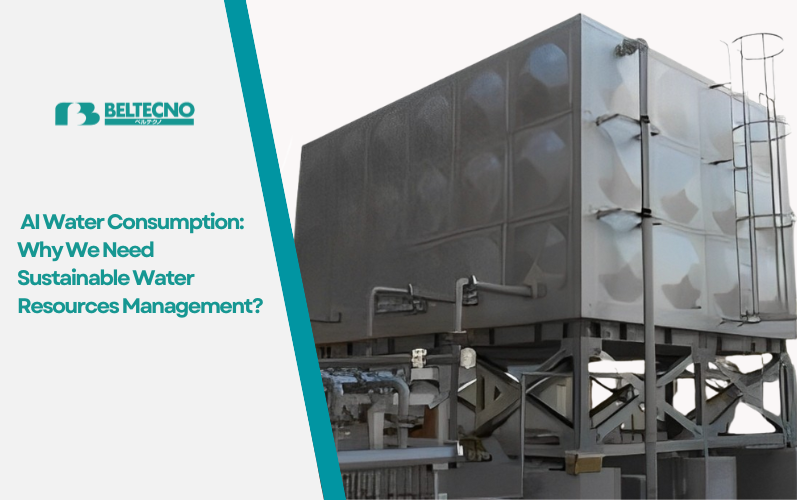AI Water Consumption: Need For Sustainable Water Resources Management?

According to a BCG report, India has passed the global average of 26% in AI usage. This is not surprising as AI usage is becoming really common in day-to-day and business environments.
There is no denying that AI has made people's lives easier, but will it be the case in future also?
Let’s find out in the blog about AI water consumption and why sustainable water resources management matters more than ever.
How AI is Consuming Water at an Alarming Rate?
A researcher at the University of California, Riverside, stated in the paper that OpenAI's ChatGPT uses approximately 500 millilitres of water for every 5 to 50 prompts it processes.
It seems a small number until you multiply this by the global population.
India alone has a population of 1.46 billion (146 crore), and it has ranked 14th in the highest number of data centres.
All these numbers are enough to understand the AI water consumption. Many cities in India are already facing water scarcity issues, and increased AI usage has added to the concern.
There are different stages of AI water consumption. Let’s try to understand how exactly AI consumes water. And what is the difference between the terms water withdrawal and water consumption?
What is Water Withdrawal and Water Consumption?
Water withdrawal refers to the concept of drawing out from natural resources like groundwater, a lake or a river. The key point is that the withdrawn water may or may not be returned to the source after use.
On the other hand, if the water is withdrawn and not returned to its primary source due to evaporation, absorption, or otherwise. Water is permanently lost or exhausted in this case.
Now, let’s understand how exactly the AI consumes water.
How Does AI Consume Water?
AI’s environmental footprint goes beyond energy. It also consumes significant amounts of water throughout its lifecycle. From training models to manufacturing chips, water is used at several critical stages. Here's how:
1. Cooling Systems in Data Centres
AI servers, especially during the training of large language models, generate enormous amounts of heat.
To prevent overheating, data centres rely on water-based cooling systems like cooling towers or evaporative chillers.
In these systems, water absorbs the heat and is then released as vapor, leading to permanent water loss through evaporation. This process accounts for the majority of on-site water consumption in AI operations.
2. Electricity Generation for AI
The vast electrical energy required to train and run AI models often comes from thermal or nuclear power plants, which themselves use large volumes of water to cool turbines.
Even though some of this water is recirculated, a significant portion is lost to steam and evaporation, making it an indirect but impactful source of water consumption.
3. Manufacturing of AI Hardware
AI performance depends heavily on high-end semiconductors, GPUs, TPUs, and advanced chips.
Producing these chips involves a water-intensive process that uses ultra-pure water (UPW) to clean silicon wafers.
In fact, manufacturing a single high-end chip can require up to 2,200 gallons (8,300 litres) of water. This stage represents embedded water use, often overlooked but essential to the hardware supply chain that powers AI.
The Need for Sustainable Water Resources Management in a Tech-Driven India
AI expansion without responsible water strategies risks depleting scarce resources and impacting vulnerable communities.
As India is leading in AI adoption, there is a huge pressure on its water resources. AI water consumption, especially in data centres and high-performance computing facilities, is significantly increasing.
These increase water demands and force us to think about sustainable water resource management, especially now, in the era of tech-driven India.
We cannot cut off the use of AI or stop innovation, but what we really need is proper and sustainable water management.
So, how can we plan smartly to integrate water management practices in the AI-driven sector?
Steps to Integrate Water-Smart Practices in AI/Data-Driven Sectors
- Mandate Water-Efficient Cooling Systems - Companies and data centres must shift to advanced cooling technologies like liquid immersion cooling or hybrid systems that use less freshwater and reduce evaporation.
- Encourage Rainwater Harvesting and Rainwater Tanks: AI campuses and tech parks should be equipped with rainwater harvesting systems integrated with high-efficiency rainwater tanks.
Beltecno’s modular stainless steel tanks allow for scalable smart water storage that complements green building initiatives. - Use of Stainless Steel Storage Tanks to Maintain Water Purity & Reduce Loss- Traditional tanks like plastic or concrete often suffer from leakage, contamination, and wear over time. The result of these issues is poor water quality and unnecessary loss.
Stainless steel storage tanks like those from Beltecno offer a smarter, long-lasting solution. They resist corrosion, reduce evaporation, maintain water purity, and require minimal maintenance.
Ideal for tech campuses and industrial use, they support efficient, sustainable water storage in high-demand environments.
How Beltecno’s Stainless Steel Tanks Offer a Sustainable Solution?

Beltecno India is a Japanese technology-based SS tank manufacturer. It is known for its welded technology and superior quality stainless steel tanks.
So, why should you consider investing in these tanks?
Beltecno water tanks are made up of stainless steel, which makes them 100% recyclable. Stainless steel material not only provides sustainable benefits, but it also saves maintenance costs and provides good ROI.
Beltecno tanks are modular type, which means you get to choose the size of your tank. It especially provides the option of customisation, so if you need some additional tools installed on your tank, it can be easily done!
Conclusion
Water storage tanks are merely containers now. It is time we begin to understand the importance of water storage tanks in water infrastructure.
AI innovation is crucial, and so is sustainable water resources management. And with the proper strategy and execution, both can work in parallel.
Invest in high-quality water tanks today to build a more sustainable tomorrow. Contact Us!